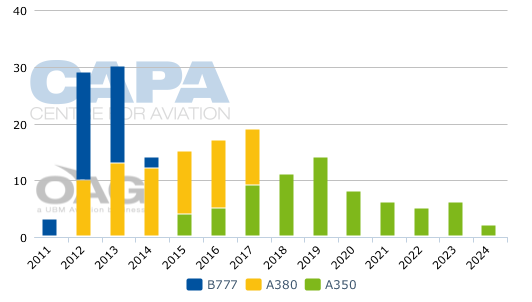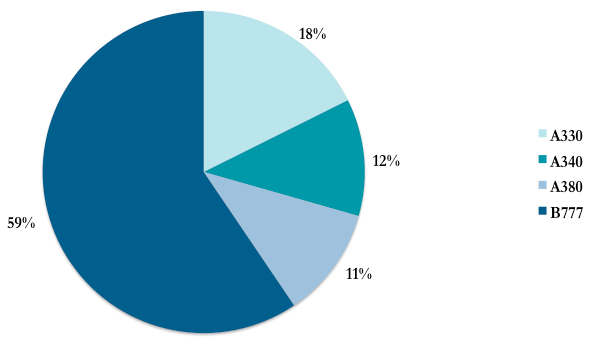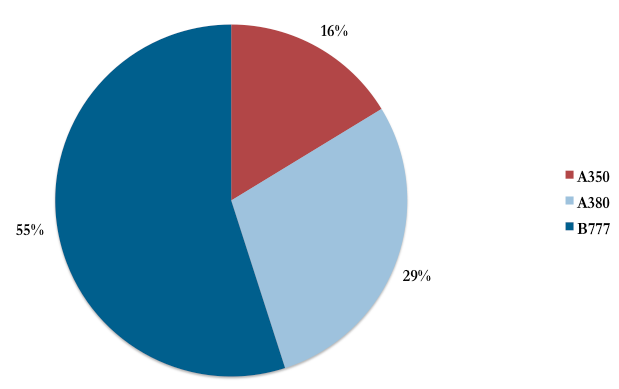What another 50 Emirates B777-300ERs means: some growth, replacement and competition for others
Emirates' purchase of 50 B777-300ERs, which at USD18 billion is the largest order by list value in Boeing's history, secures Emirates the capacity for its medium-term expansion plans and the ability to complement passenger-efficient A380s with cargo-efficient B777s. Half of the new 50 B777s can be estimated to continue replacement of older A330s, A340s and B777s. The remaining half will only open about 10 ultra-long-haul routes, so CEO Tim Clark is far from concluding long-term fleet shopping. Looming is an order in the next year or two of the next generation B777, the -8X and -9X, if Boeing can meet Emirates' specification.
With the revamped B777 possibly entering service by the end of the decade, the aircraft will offer Emirates further efficiency improvements as competitors try to level the field with A350s and B787s. As Emirates grows in efficiency, so too does its threat to airlines already feeling immense pressure.
With the new order, Emirates' fleet in 2020 can be estimated to fall at around 275-300 aircraft, all widebodies, up from the present 165. While United-Continental may eclipse Emirates with over 700 aircraft, widebodies will likely only account for around 200 aircraft. Lufthansa could have a widebody fleet of around 100 by 2020.
A340 ends production but no stopping the B777 or Emirates - except for airports
Emirates' order on the first day of the Dubai Airshow follows last week's decision by Airbus to end production of its A340 programme. While the four-engined aircraft was once pitted against the twin-engined B777, and fuel costs have dramatically increased since the middle of the previous decade, the B777 has far eclipsed the A340. Airbus will end A340 production with about 377 orders whereas Boeing has 1345 orders and counting for the B777.
Having ordered dozens of A380s and B777s in the past year, Emirates continues to make long-term capital acquisitions despite the short-term negative global economic outlook - although it has posted sustained and hearty profits. This ensures Emirates will have capacity in place for when rebounds occur. Mr Clark has even remarked in the past year Emirates would be ordering more aircraft if it were not for destination airports not taking the Middle East juggernaut seriously, or its home airport at Dubai running out of expansion opportunities prior to the move to Dubai World Central mid next decade.
Fifty B777-300ERs for medium-term growth
The 50 B777-300ERs ordered with options on another 20 may seem daunting considering Emirates still has 41 B777-300ERs on order and 61 already in service, according to CAPA/OAG iFleet data. The 41 aircraft on order are projected to primarily be delivered in 2012 and 2013 and provide for expansion as well as replacement of older aircraft. This leaves Emirates with no single-deck large capacity aircraft until A350-1000s are delivered after 2017, a date that is continuously slipping.
Emirates projected delivery dates for all aircraft as at 12-Nov-2011 (prior to new order)

The 50 new B777-300ERs will provide ultra-long-haul and high-capacity growth, largely in tandem with A380s, primarily between 2014 and 2017. More growth can be expected earlier in that period than later when some of the ordered aircraft could potentially replace initial B777-300ERs, which would be over 10 years old by then - high for a network carrier focussed on having a young fleet age.
For ultra-long-haul services to America and Australia stretching for 14 hours, Emirates would require 2.5 aircraft for a daily service, which it has shown to be its preference when entering markets. With half of the 50 B777-300ERs allocated as replacements or to up-gauge capacity, Emirates could open or upgauge 10 daily flights. It has stated it plans to increase in the medium-term future its Australian capacity from about 10 daily flights to 15. The trip lengths involved would require a B777-200LR/300ER or A380.
Emirates is also eyeing aggressive expansion in America after slowing down its growth last decade when the market contracted after the September 11 terrorist attacks. Mr Clark is eyeing Chicago and possibly Philadelphia, amongst other destinations. Frequency increases are expected, but more likely to occur with higher payload A380s the carrier will begin receiving in 2013.
See related article: Aircraft availability and capability continues to determine Emirates expansion plans
It is easy to theoretically allocate the B777-300ER order to America and Australia without touching Asia, Africa, South America or potential medium-haul or fifth-freedom services, leaving no doubt Emirates' expansion is truly achievable.
New B777 variants for the long-term
Boeing and Emirates continue to discuss a new version or versions of the B777 family that would have a higher payload than the B777-300ER following a re-engining and construction of a new wing, likely out of composites. Emirates is pushing for an entry-into-service date of 2017, the same year the A350-1000, the closest A350 variant that is a competitor to the B777-300ER, is due to enter into service. Boeing believes an entry-into-service date closer to the end of the decade is more likely. Should predictions hold true of further A350-1000 delays, the later entry-into-service date of the new B777 will be less significant. Boeing has held A350-1000 delays are helping its B777-300ER, and Emirates' order is a partial vindication of that.
If Boeing can meet Mr Clark's specifications that always push the operating envelope - he has driven the B777-300ER's performance improvements but did not order the B747-8i when it fell short of his requests - Boeing can expect a handsome order from Emirates. The new B777, possibly the -8X, -9X or -10X, would narrow the 20% efficiency improvement the A350-1000 claims over the B777-300ER, although the A350-1000 has a smaller payload than the B777-300ER. (This new B777, if it comes to fruition, would lessen the business case for the B747-8i.)
The B777 accounts for 59% of passenger aircraft in Emirates' fleet today. Conservative estimates see it decrease marginally to 55% by 2020 as A380s will account for more of Emirates' fleet by then. The projection, however, is contingent on exercising of options of all types as well as any new variants entering the market.
Emirates current (top) and 2020 (bottom) fleet proportion projection as at 14-Nov-2011

As aircraft improvements increase Emirates' efficiency, its advantage over legacy airlines will continue to grow, even if competitors acquire similar equipment. Emirates' order for 50 B777-300ERs is pale in comparison to future orders that can be expected, but also pale is the pressure and resulting outbursts legacy airlines feel. European carriers have made their discontent known, and as Emirates expands in new markets, like America, more discontent can be expected to emerge.
Pairing of A380 and B777-300ER
Mr Clark has made the B777 his workhorse yet is upbeat about the A380's future - and rightfully so as the two aircraft are complementary. With Mr Clark expecting Emirates to serve long-haul destinations twice daily, Emirates can be expected to continue to deploy both A380s and B777-300ERs on city pairings. The A380's higher seat count (489 to the B777-300ER's 358) is ideal for slot-restrained airports and peak hour services. The B777-300ER offers superior cargo capability (201 cubic metres to the A380's 184, which must accommodate more passenger luggage), making it ideal to complement the A380.
Of the 10 long-haul/ultra-long-haul destinations Emirates deploys or has announced plans to deploy its A380 to, seven also see B777-300ER service: Bangkok, Hong Kong, Johannesburg, Kuala Lumpur, New York-JFK, Shanghai and Sydney. Of the three destinations that do not see B777-300ER service, Toronto is constrained by slots, Beijing sees an A340 service (making it ripe for an eventual B777-200LR/-300ER takeover) and Seoul sees no other Emirates service.
This pattern is replicated across other airlines, with Korean Air deploying an A380 and B777-300ER to New York-JFK and Singapore Airlines doing the same to London Heathrow, Melbourne and Tokyo, amongst other airline and destination combinations.
